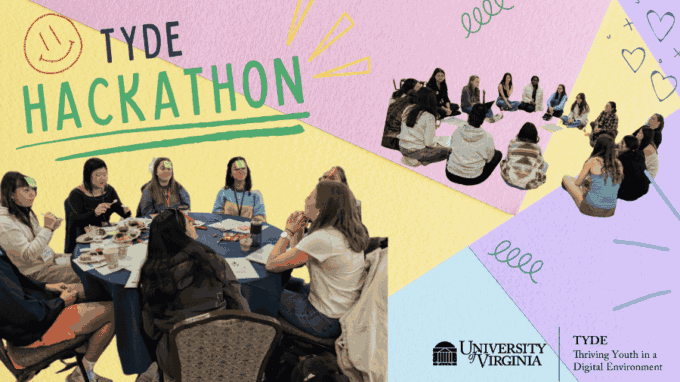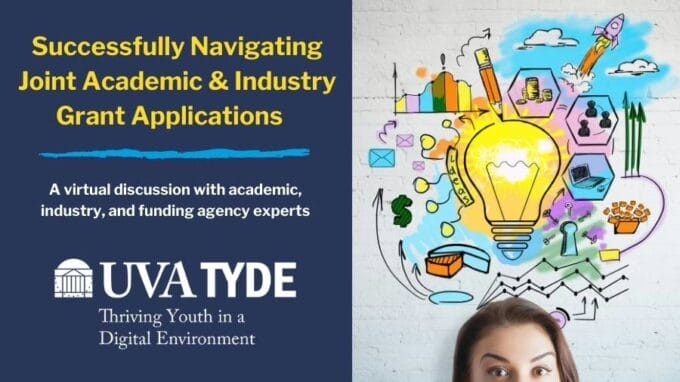By Jessica Harris & Bhavika Suryawanshi
On a warm Friday evening in early June, the Phaeton Gallery in Charlottesville was filled with conversation, color, and reflection. The occasion? The opening night of True Colors: Exploring Mental Health Through Art, a youth art exhibit that brought together students, families, educators, and community members to grapple with the question: How does digital technology affect mental health?
Hosted by the Thriving Youth in a Digital Environment Initiative (TYDE), this exciting event was more than just an art show. It gathered community voices, offered a space for reflection, and celebrated students’ creativity and courage.
More than 20 young artists, grades 7th-10th in Albemarle County, VA contributed to the exhibit. Their works included digital illustrations, sketches, paintings, hand-drawn comics, and physical art. Each piece responded to the prompt on how digital technology impacts youth mental health.
The result was a raw, thoughtful, and deeply personal visual conversation. Some works portrayed the burden of social media and screen time, with its addictive nature and often less-than-positive content. Others highlighted the ways in which technology can help connect students to each other.
The exhibit itself was curated by a high school student intern, Alyssa Lee, who worked under the mentorship of Phaeton Gallery owner, Lisa Hogan, to curate the visitor experience. Another student intern, Nyameye Adom, also provided outreach support and helped emcee the exhibit.
As guests arrived, they were prompted to engage in reflection throughout the exhibit. Large pieces of paper asked visitors to answer:
- Do you think cell phones should be banned in school?
- Bell-to-bell
- In classrooms
- At lunchtime
- On the school bus
- Not at all
- Should there be 1-hour social media limits for youth under 16?
- Yay/Nay
- I do something to take care of my mental health:
- Every day
- Every week
- Once a month
- Never
Other open-ended questions included:
- What’s one thing you do to support your mental health?
- What supports or resources do we need in our local community to support youth mental health?
- What word or phrase would you use to describe how technology affects your mental health?
At TYDE, we’re dedicated to amplifying youth voices on the issues that shape their lives. In a world where young people are constantly navigating numerous challenges and pressures, art can offer something rare and vital: a safe, powerful space to be heard. Art allows us to share what we might not be able to speak, a place to be vulnerable, and an opportunity to connect and spark dialogue. A single image can capture what a dozen conversations might not.
These pieces gave students a chance to be heard, and gave gallery visitors a chance to listen and respond.
Survey Results
Both adults and youth agreed that social media can be exciting because of its ability to entertain and connect like-minded people through things like funny videos, educational content, and shared interests. On the other hand, adults were more concerned about the spread of misinformation and the lack of privacy that comes with social media, while youth were worried about overconsumption and comparing themselves to others.
Of those who attended the event, more adults used messaging platforms like iMessage and email, as well as popular social media apps like Instagram and TikTok. The youth primarily used video streaming platforms like YouTube and gaming platforms like Roblox. Both groups used music streaming services like Spotify.
When asked if adults and youth did something to take care of their mental health, most responded with “every day,” while some said “every week.” Additionally, when asked if there should be 1-hour social media limits for youth under 16, 13 people said “Yay” (yes), with 11 out of 17 adults and 2 out of 5 children agreeing.
When students were asked what they wished adults understood about how technology affects their mental health, one student responded by saying that social media changes the way they live; as expectations evolve, so do they. Another student said it helps them positively, as they use Spotify to engage with music to help stimulate their thinking.
Most attendees agreed that technology can be draining and overwhelming, causing feelings of anxiety and exhaustion. They believed that offering supportive spaces (such as peer circles, quiet rooms, and community centers) and increasing access to trained adults (such as therapists and peer mentors) would help the community overcome the negativity surrounding technology. They also noted that schools, families, and programs could set limits on tech use and teach media literacy while offering screen-free alternatives to better support students’ mental health.
On the other hand, attendees were asked what they used and did to improve and support their mental health. They recommended numerous apps for this purpose, including Finch, Calm, Spotify/Apple Music, NYT Puzzles, the Notes app, and audiobooks. Many participants (approximately eight) said they enjoyed taking walks outside and spending time in the natural beauty of Charlottesville. Most mentioned engaging in physical activities (exercise, sports), individual activities (reading, playing an instrument, solving puzzles), connecting with close relationships (cooking for family, spending time with friends), or quiet pastimes (meditation, reading, long baths).
Finally, attendees were asked about phone policies in schools. When asked where phones should be stored when not in use, 14 said in their backpacks, and 7 suggested similar options (locked pouches or lockers). When asked if phones should be banned, 15 said yes during classrooms, 6 said yes for the whole school day, 5 said no for the whole day, and 5 said no on the bus. Overall, participants agreed phones should be banned during important instructional time.
Conclusion
Often, young people are talked about in conversations about their mental health, but not often included directly in the dialogue. This exhibit flipped that narrative. Every piece of art, every caption, and every conversation that night made clear: young people know exactly what’s going on. They just need space to express it.
Perhaps the most powerful part of the evening was not merely the students’ remarkable and breathtaking artwork, but the robust and fruitful conversations that were had as part of the exhibit. Parents, teachers, community members, and youth all discussed their takeaways and their personal experiences with technology and mental health. This breaking down of divides and intergenerational conversation was transformative.
Each and every one of the students who submitted a piece of art to the exhibit shared a piece of themselves, and it was moving to see the community support them with such care. Events like these remind us of the importance of community and gathering to be able to move the needle forward.
At TYDE, we’ll keep making space for that expression: not just because it’s powerful, but because it’s a necessary point for dialogue.



